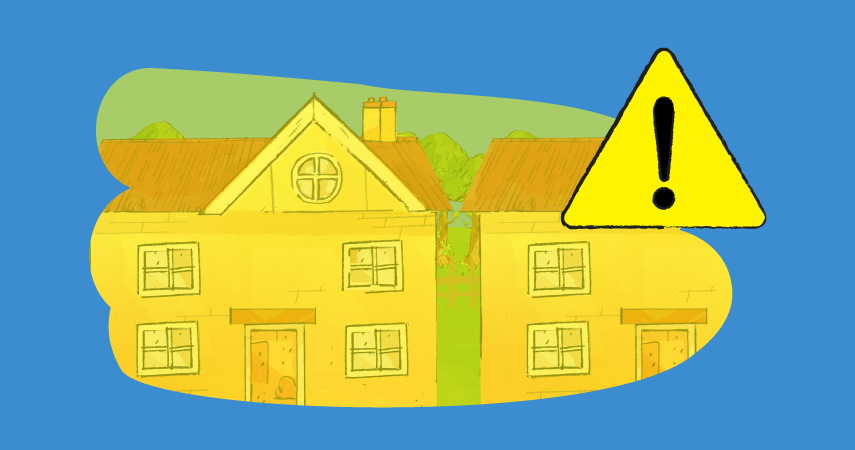A Landlord’s Guide to Asbestos Awareness

Health and safety specialist Louise Petty explains what asbestos is and what your responsibilities are as a landlord:
What is Asbestos?
Asbestos is a hazardous substance that causes ill-health to anyone who disturbs it. There are 3 main types – chrysotile, amosite and crocidolite – which are mined in many countries around the world before being used to create household products and building materials.
Fortunately, asbestos is no longer used or imported in the UK (it was banned in 1999) due to the health hazards it creates. However, it’s still common in existing buildings, especially those built before the year 2000.
If you are the landlord of a property built before the year 2000 you should therefore be especially vigilant and ensure you have a good awareness of the risks.
Where is Asbestos Found in Rental Properties?
Although the manufacture (and use) of asbestos products was banned in the UK in November 1999, asbestos containing materials still widely exist in buildings and products installed before this date. The use of asbestos was particularly popular during the 1950s to 1980s, so pay particular attention if you rent out a property that was built or refurbished during this period.
Asbestos was used so extensively because it possesses many idyllic properties. Amongst other things, asbestos is strong, incombustible, heat-resistant, cheap, sound absorbent and can control condensation. It could be used to make all sorts of products – from roof tiles to kitchen paper -making it easy to see why it was so popular.
Consequently, in a rental property asbestos may be found in almost any material. Some of the most common locations include:
- Textured wall and ceiling coatings, such as Artex.
- Floor tiles
- Asbestos insulating board in walls, ceilings and doors.
- Baking paper and cardboard.
- Fire blankets and fire doors.
- Roof felt.
- Guttering and pipe work.
- Bath panels.
- Garage roofs.
What Are the Health Hazards?
Prior to it being banned in 1999, asbestos was widely used because people were simply unaware of the health hazards it created. This was perhaps because the onset time of asbestos-related illnesses can be anything from 15 to 60 years after the initial exposure, so at the time people weren’t experiencing any immediate symptoms of ill-health.
However, this means that those people who were regularly exposed to asbestos fibres in the 1970s may only just be beginning to experience the harmful after-effects now.
These days, around 4,000 people die each year from cancers caused by inhaling asbestos fibres. Amongst these, public health advocate Linda Reinstein bravely tells the story of her husband, Alan, who was diagnosed with mesothelioma in 2003 and the struggle she now faces trying to raise awareness of asbestos dangers.
How Does Asbestos Cause Ill-Health?
Asbestos causes harm to people’s health when the fibres, suspended in the air, are inhaled. A singular, short exposure to asbestos is unlikely to do you much damage but regular or prolonged exposure to the harmful fibres has the potential to cause serious problems further down the line.
The fibres are released when the asbestos containing material is damaged or disturbed. This can occur during all kinds of activities, such as drilling holes in the wall, knocking down walls or out-buildings, removing plasterboard and tearing up old cardboard. If you suspect that asbestos may be present in your rental property and plan to carry out work then it’s essential that you assess the risks first.
On the other hand, if asbestos containing materials are not damaged or disturbed and are left alone then the fibres will not be released and they will do no harm.
Who is at Risk from Asbestos?
Anyone who disturbs or damages an asbestos containing material, and who consequently inhales the harmful fibres, is at risk from ill-health.
Tradesmen such as plumbers, carpenters, electricians and gas fitters are most at risk, as are those who take part in any other sort of building repair or refurbishment, like plasterers, roofers, decorators and heating engineers.
HSE research tells us that, on average, every week in the UK:
- 4 plumbers die.
- 20 tradesmen die.
- 6 electricians die.
- 8 joiners die.
What are Landlords’ Legal Responsibilities?
Under the Control of Asbestos Regulations 2012 (CAR 2012), employers and the self-employed must prevent people from being exposed to asbestos or else reduce the risk to as low a level as possible.
These regulations apply to landlords but the legislation is somewhat confusing, as the law only refers to ‘non-domestic’ properties. This means that you have a legal responsibility to assess the risks from asbestos in all common parts where people don’t live, such as entrance halls, stairways, shared roof-spaces, shared garages, boiler rooms and communal gardens.
The law requires you to find out if asbestos is present in these communal parts and protect people from the hazards. If you locate asbestos containing materials then you should make a record of the location and type of asbestos and ensure a plan is in place to manage the risks and monitor any changes in its condition.
If you intend to instruct tradesmen to work on your property then you should inform them of the presence of asbestos (or suspected presence) before they begin work.
Perhaps confusingly, under CAR 2012, private residences like individual flats, private houses and private rooms etc are not covered by the same requirements and so you don’t have a ‘duty’ to manage asbestos risks. However, it’s still seen as good practice to assess the risks in order to keep your tenants from harm.
The Defective Premises Act 1972 reiterates the importance of protecting tenants from personal injury or disease caused by a defect in the state of the property. Whilst asbestos isn’t specifically mentioned within this law, it makes sense to assume it is included. You should therefore do all that you can to identify the hazards and ensure they are controlled.
What Should You Do If You Suspect Asbestos is Present?
If you, a tenant or a tradesman suspects that asbestos may be present in the property then your first step is to leave it alone. Disturbing or trying to move the asbestos will cause harmful fibres to be released so it’s important that you don’t try and remove it yourself.
Inform your local authority of your suspicions and arrange for the material to be tested and/or removed by a licensed contractor if necessary.
If the asbestos is in good condition and hasn’t been damaged or disturbed then it’s safe to leave it in situ. Simply label the material as ‘contains asbestos’ and make a note of its location for future reference.
If the asbestos is in poor condition (either damaged or disturbed) then it should be removed by a licensed asbestos removal company. Never try to remove asbestos containing materials yourself.
If you think that you, a tenant or a tradesman has been exposed to asbestos fibres, or if they have developed ill-health as a result of exposure, then it is essential that you see a doctor straight away. The doctor can give a diagnosis and inform you of what action to take next.
Louise Petty is a training course author for High Speed Training and a health and safety specialist. She writes educational materials around a wide range of topics, but specialises in Legionella, Asbestos Awareness and COSHH.
Disclaimer: This article is for information only and is not official guidance, FCA approved, or legally precise. Just Landlords has used all reasonable care in compiling the information but make no warranty as to its accuracy. If you require information on landlord legislation or best practices please contact your legal representative. For details see our conditions.



